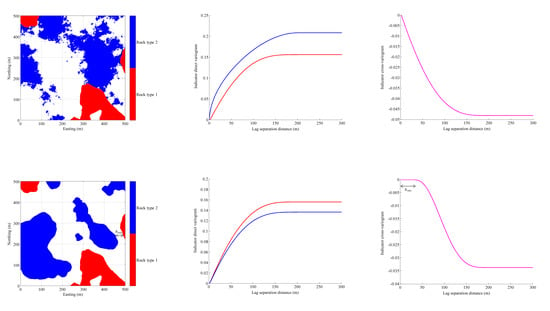Indicator Variograms as an Aid for Geological Interpretation and Modeling of Ore Deposits
Abstract
:1. Introduction
2. Materials and Methods
2.1. Indicator Modeling
2.2. Theoretical Indicator Direct Variogram
2.3. Experimental Indicator Direct Variogram
2.4. Theoretical Indicator Cross-Variogram
2.5. Experimental Indicator Cross-Variogram
2.6. Link between Indicator Direct and Cross-Variograms
2.7. Ratio of Indicator Cross-to-Direct Variograms and Edge Effects
- : due to Equations (19) and (20), where is a point located close to x. Knowing that x belongs to Dk decreases the probability that x’ belongs to Dk′, given that it does not belong to Dk This means that the contact area between Dk and Dk′ is smaller than it would be in the absence of edge effect, i.e., there is a propensity for both domains not to be in contact (Figure 4A,B).
- : the contact area between domains Dk and Dk′ coincides with the expected contact area in the absence of edge effect (no preferential contact) (Figure 4C,D).
- : the contact area between Dk and Dk′ is larger than it would be in the absence of edge effect. There is a propensity for both domains to be in contact together (Figure 4E,F).
3. Case Study and Results
3.1. Presentation of the Deposit
- Andesite (code 1): this volcanic rock is distributed as an interbedded sequence spread over the whole deposit and consists of lavas, auto-breccias and ocoites, with porphyritic to aphanitic texture and, locally, with amygdaloidal to ocoitic texture.
- Other volcanic rocks (code 2): this is a sequence of differentiated volcanic rocks with textures that vary from porphyritic to tuffaceous with an aphanitic matrix.
- Sedimentary rocks (code 3): this rock type includes undifferentiated, volcaniclastic and calcareous sediments, which are mostly interbedded with dacite and andesite, forming the host rock of the intrusive porphyry.
- Granodioritic porphyry (code 4): this is a medium grain granodiorite of Triassic age.
- Monzonitic porphyry (code 5): this porphyry rock is associated with the hypogene mineralization.
- Hydrothermal breccia (code 6) with tourmaline, quartz, chalcopyrite and pyrite cements, which can be found in the contact between the monzonitic porphyry with the host rock as a breccia with intrusive fragments.
3.2. Data Presentation and Pre-Processing
3.3. Indicator Direct Variograms
3.3.1. Existence of a Sill
3.3.2. Shape and Anisotropy
3.3.3. Slope at the Origin
3.4. Indicator Cross-Variograms
3.4.1. Behavior at Large Distances
3.4.2. Behavior at Short Distances
3.5. Ratios of Indicator Cross-to-Direct Variograms
4. Discussion
4.1. Geological Interpretation and Modeling
4.2. Geostatistical Modeling and Simulation
5. Conclusions
Acknowledgments
Author Contributions
Conflicts of Interest
Appendix A
- : the contact area between Dk and Dk′ when moving along vector u (i.e., leaving Dk at x and reaching Dk′ at ) is smaller than it would be in the absence of a directional edge effect.
- : the contact area between Dk and Dk′ when moving along vector u is equal to the expected area in the absence of a directional edge effect.
- : the contact area between Dk and Dk′ when moving along vector u is larger than it would be in the absence of an edge effect.
References
- Dowd, P.A. Structural controls in the geostatistical simulation of mineral deposits. In Geostatistics Wollongong’96; Baafi, E.Y., Schofield, N.A., Eds.; Kluwer Academic: Dordrecht, The Netherlands, 1997; pp. 647–657. [Google Scholar]
- Vargas-Guzmán, J.A. Transitive geostatistics for stepwise modeling across boundaries between rock regions. Math. Geosci. 2008, 40, 861–873. [Google Scholar] [CrossRef]
- Rossi, M.E.; Deutsch, C.V. Mineral Resource Estimation; Springer: London, UK, 2014; p. 332. [Google Scholar]
- Madani, N.; Emery, X. Plurigaussian modeling of geological domains based on the truncation of non-stationary Gaussian random fields. Stoch. Environ. Res. Risk Assess. 2017, 31, 893–913. [Google Scholar] [CrossRef]
- Mery, N.; Emery, X.; Cáceres, A.; Ribeiro, D.; Cunha, E. Geostatistical modeling of the geological uncertainty in an iron ore deposit. Ore Geol. Rev. 2017, 88, 336–351. [Google Scholar] [CrossRef]
- Matheron, G.; Beucher, H.; de Fouquet, C.; Galli, A.; Guérillot, D.; Ravenne, C. Conditional simulation of the geometry of fluvio-deltaic reservoirs. In Proceedings of the SPE Annual Technical Conference and Exhibition, Dallas, TX, USA, 27–30 September 1987; Society of Petroleum Engineers: Richardson, TX, USA, 1987; pp. 591–599. [Google Scholar]
- Ravenne, C.; Galli, A.; Doligez, B.; Beucher, H.; Eschard, R. Quantification of facies relationships via proportion curves. In Geostatistics Rio 2000; Armstrong, M., Bettini, C., Champigny, N., Galli, A., Remacre, A., Eds.; Kluwer: Dordrecht, The Netherlands, 2002; pp. 19–40. [Google Scholar]
- Xu, C.; Dowd, P.A.; Mardia, K.V.; Fowell, R.J. A flexible true plurigaussian code for spatial facies simulations. Comput. Geosci. 2006, 32, 1629–1645. [Google Scholar] [CrossRef]
- Carle, S.F.; Fogg, G.E. Transition probability-based indicator geostatistics. Math. Geol. 1996, 28, 453–476. [Google Scholar] [CrossRef]
- Carle, S.F.; Fogg, G.E. Modeling spatial variability with one- and multidimensional continuous-lag Markov chains. Math. Geol. 1997, 29, 891–918. [Google Scholar] [CrossRef]
- Boisvert, J.B.; Pyrcz, M.J.; Deutsch, C.V. Multiple point metrics to assess categorical variable models. Nat. Resour. Res. 2010, 19, 165–175. [Google Scholar] [CrossRef]
- Dimitrakopoulos, R.; Mustapha, H.; Gloaguen, E. High-order statistics of spatial random fields: Exploring spatial cumulants for modeling complex non-Gaussian and non-linear phenomena. Math. Geosci. 2010, 42, 65–99. [Google Scholar] [CrossRef]
- Lantuéjoul, C. Geostatistical Simulation: Models and Algorithms; Springer: Berlin/Heidelberg, Germany, 2002; p. 256. [Google Scholar]
- Séguret, S.A. Analysis and estimation of multi-unit deposits: Application to a porphyry copper deposit. Math. Geosci. 2013, 45, 927–947. [Google Scholar] [CrossRef] [Green Version]
- Beucher, H.; Renard, D. Truncated Gaussian and derived methods. C. R. Geosci. 2016, 348, 510–519. [Google Scholar] [CrossRef]
- Armstrong, M.; Galli, A.; Beucher, H.; Le Loc’h, G.; Renard, D.; Doligez, B.; Eschard, R.; Geffroy, F. Plurigaussian Simulations in Geosciences; Springer: Berlin/Heidelberg, Germany, 2011; p. 176. [Google Scholar]
- Matheron, G. Eléments Pour une Théorie des Milieux Poreux; Masson: Paris, France, 1967; p. 166. [Google Scholar]
- Dubrule, O. Indicator variogram models: Do we have much choice? Math. Geosci. 2017, 49, 441–465. [Google Scholar] [CrossRef]
- Emery, X.; Lantuéjoul, C. Geometric covariograms, indicator variograms and boundaries of planar closed sets. Math. Geosci. 2011, 43, 905–927. [Google Scholar] [CrossRef]
- Roth, C. Incorporating information about edge effects when simulating lithofacies. Math. Geol. 2000, 32, 277–300. [Google Scholar] [CrossRef]
- Rivoirard, J. Weighted variograms. In Geostatistics 2000 Cape Town; Kleingeld, W.J., Krige, D.G., Eds.; Geostatistical Association of Southern Africa: Cape Town, South Africa, 2001; pp. 145–155. [Google Scholar]
- Emery, X.; Ortiz, J.M. Weighted sample variograms as a tool to better assess the spatial variability of soil properties. Geoderma 2007, 140, 81–89. [Google Scholar] [CrossRef]
- De Souza, L.E.; Costa, J.F.C.L. Sample weighted variograms on the sequential indicator simulation of coal deposits. Int. J. Coal Geol. 2013, 112, 154–163. [Google Scholar] [CrossRef]
- Emery, X. Reducing fluctuations in the sample variogram. Stoch. Environ. Res. Risk Assess. 2007, 21, 391–403. [Google Scholar] [CrossRef]
- Clark, R.G.; Allingham, S. Robust resampling confidence intervals for empirical variograms. Math. Geosci. 2011, 43, 243–259. [Google Scholar] [CrossRef]
- Olea, R.A.; Pardo-Igúzquiza, E. Generalized bootstrap method for assessment of uncertainty in semivariogram inference. Math. Geosci. 2011, 43, 203–228. [Google Scholar] [CrossRef]
- Chilès, J.P.; Delfiner, P. Geostatistics: Modeling Spatial Uncertainty; Wiley: New York, NY, USA, 2012; p. 699. [Google Scholar]
- Goovaerts, P. Geostatistics for Natural Resources Evaluation; Oxford University Press: New York, NY, USA, 1997; p. 480. [Google Scholar]
- Wackernagel, H. Multivariate Geostatistics: An Introduction with Applications; Springer: Berlin/Heidelberg, Germany, 2003; p. 388. [Google Scholar]
- Mariethoz, G.; Caers, J. Multiple-Point Geostatistics: Stochastic Modeling with Training Images; Wiley: New York, NY, USA, 2014; p. 376. [Google Scholar]
- Langlais, V.; Beucher, H.; Renard, D. In the shade of the truncated Gaussian simulation. In Proceedings of the Eighth International Geostatistics Congress, Santiago, Chile, 1–5 December 2008; Ortiz, J.M., Emery, X., Eds.; Gecamin Ltda: Santiago, Chile, 2008; pp. 799–808. [Google Scholar]
- Le Blévec, T.; Dubrule, O.; John, C.M.; Hampson, G.J. Modelling asymmetrical facies sucessions using pluri-Gaussian simulations. In Geostatistics Valencia 2016; Gómez-Hernández, J.J., Rodrigo-Ilarri, J., Rodrigo-Clavero, M.E., Cassiraga, E., Vargas-Guzmán, J.A., Eds.; Springer International Publishing AG: Cham, Switzerland, 2017; pp. 59–75. [Google Scholar]

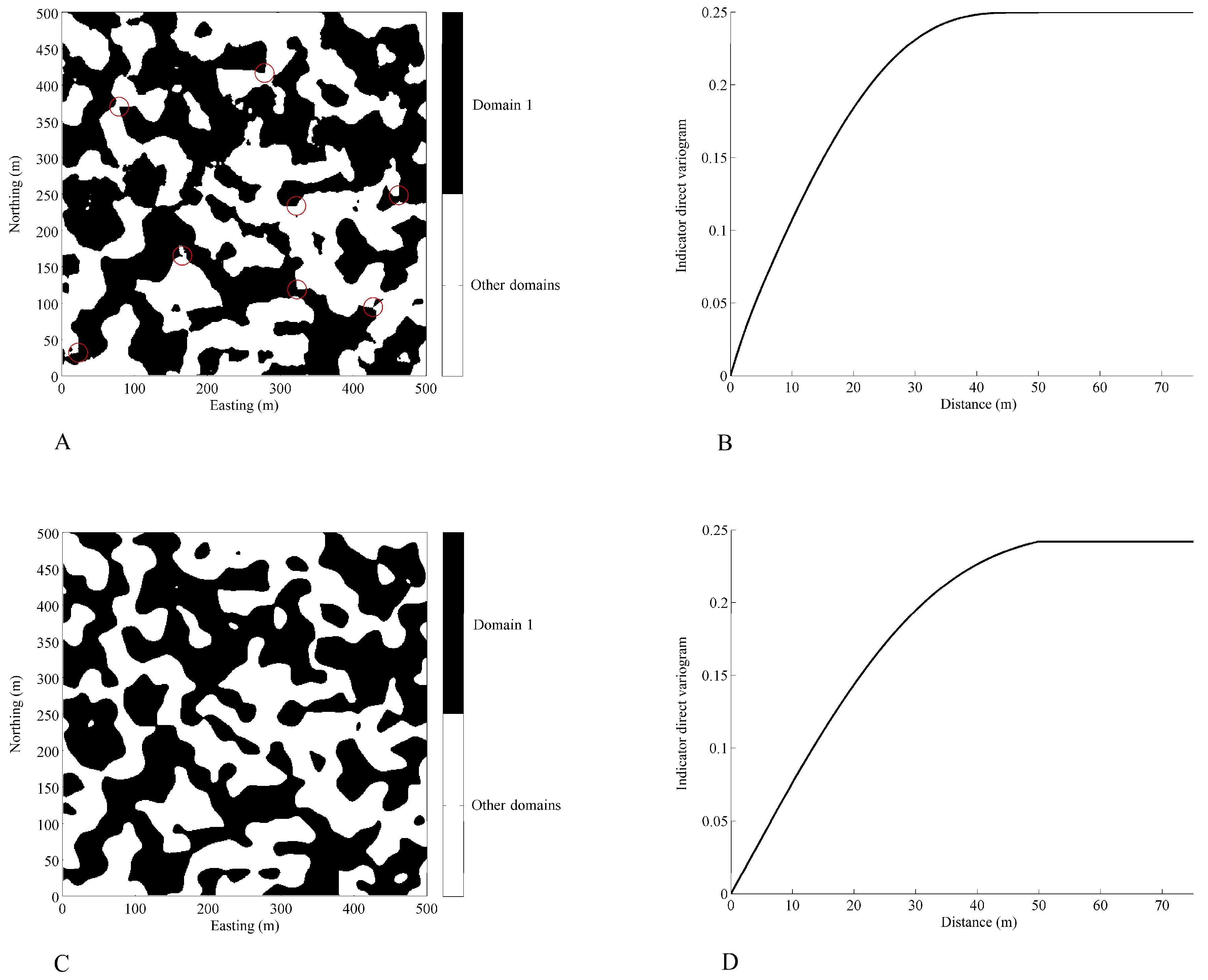

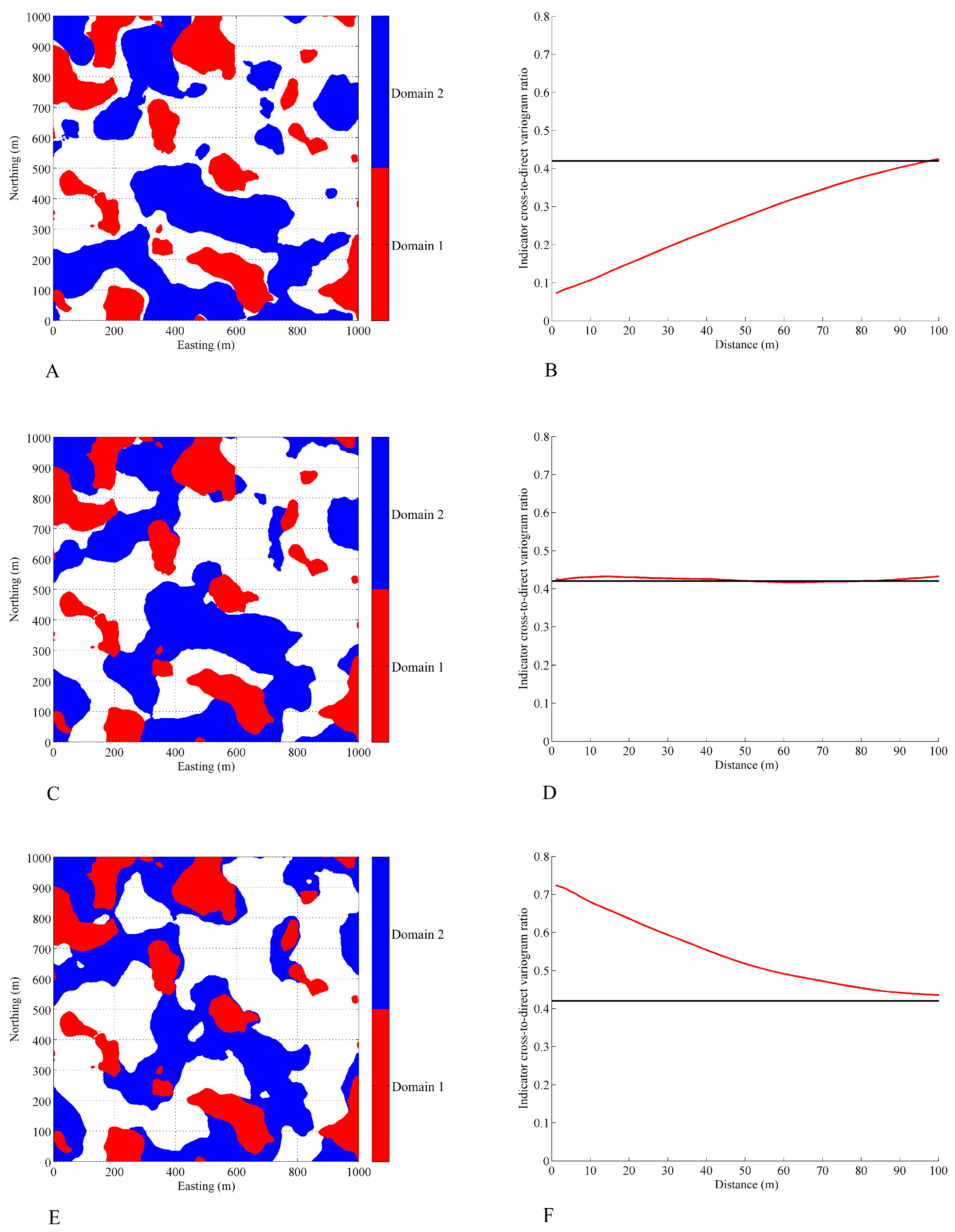
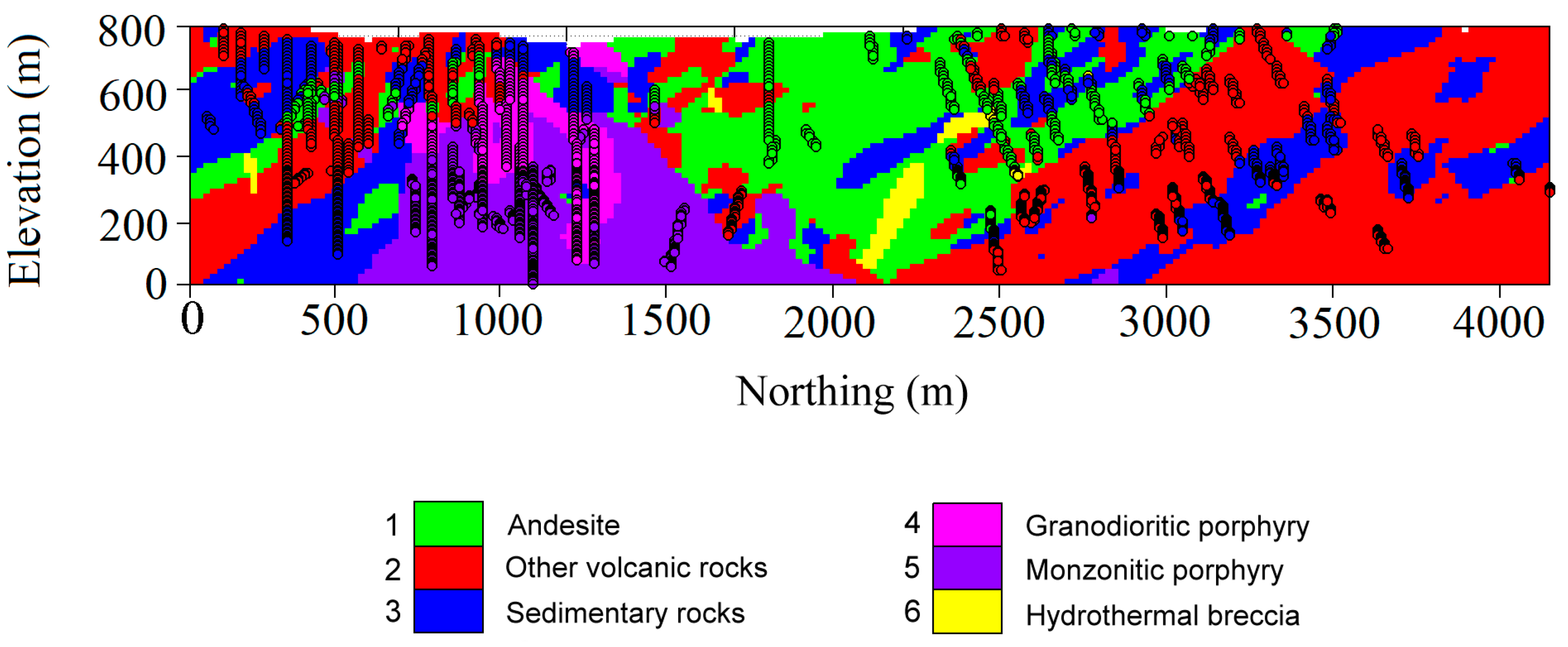
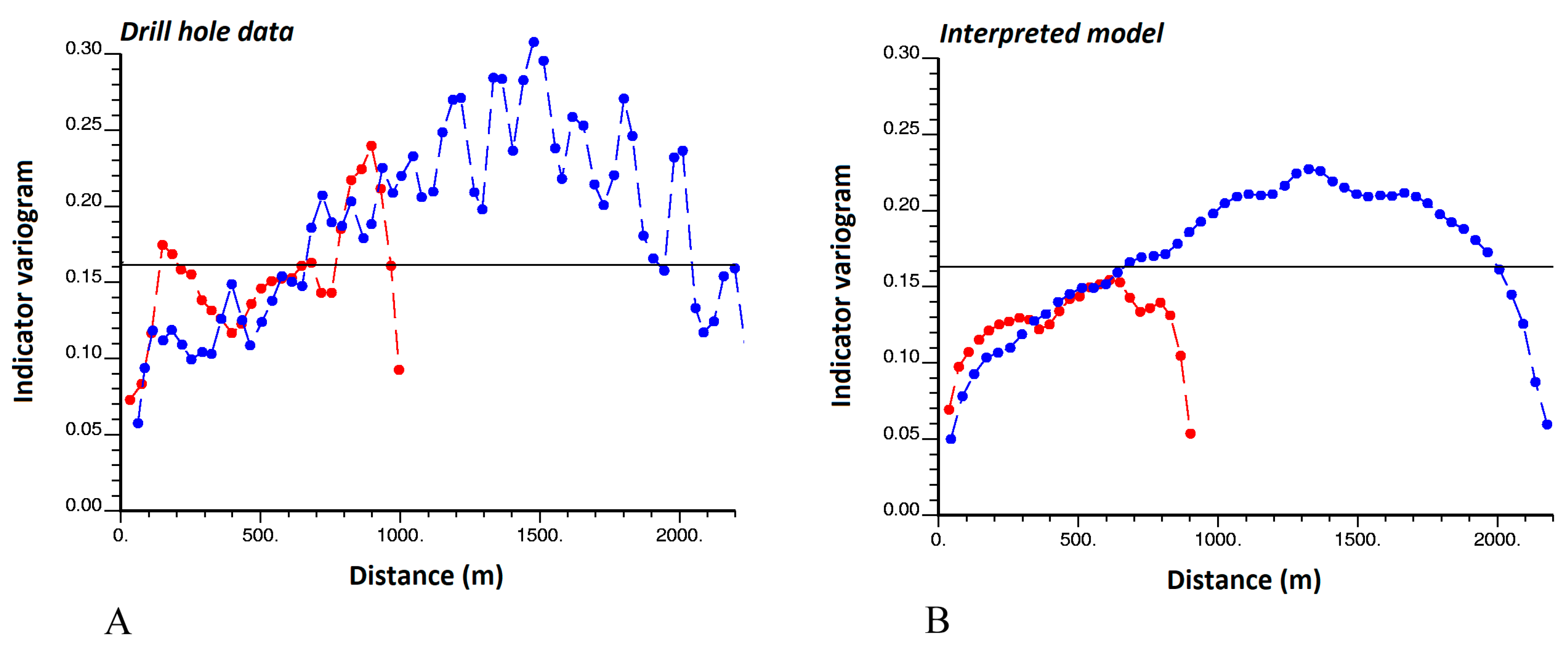

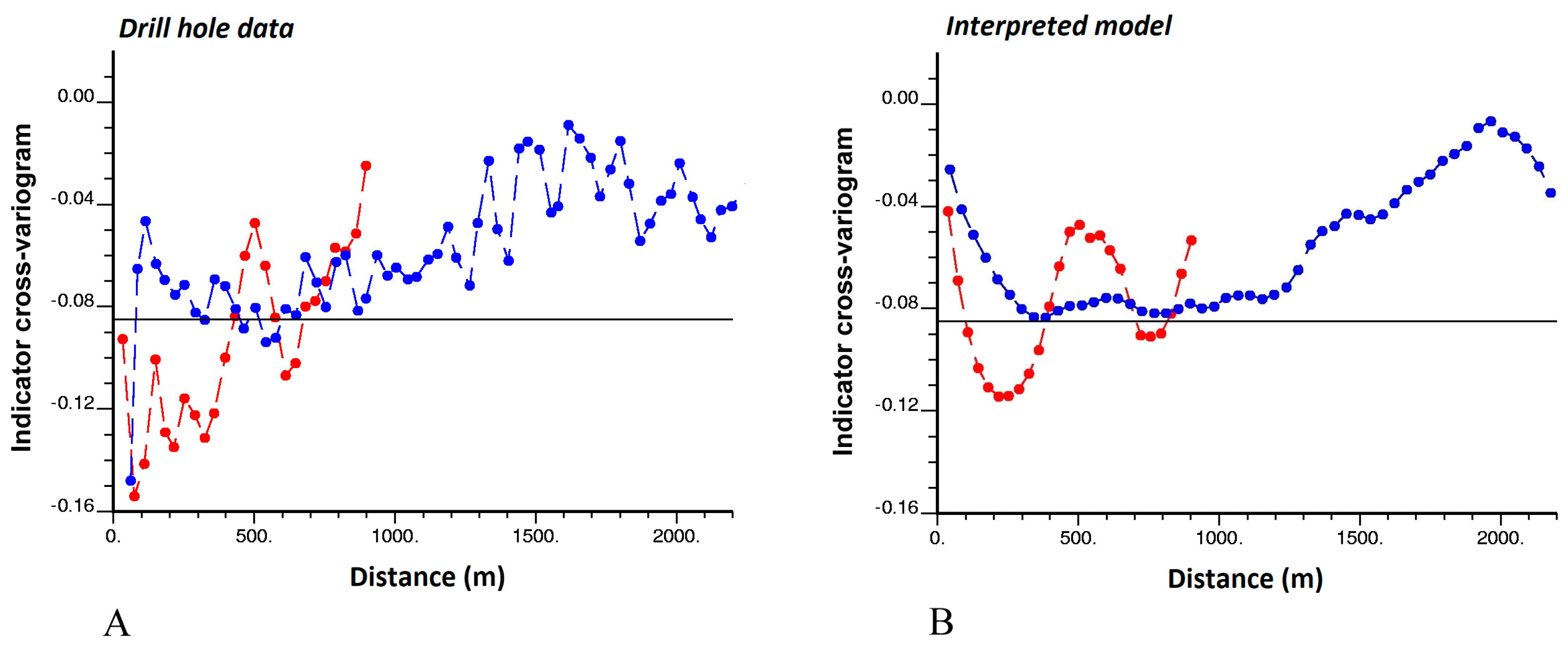
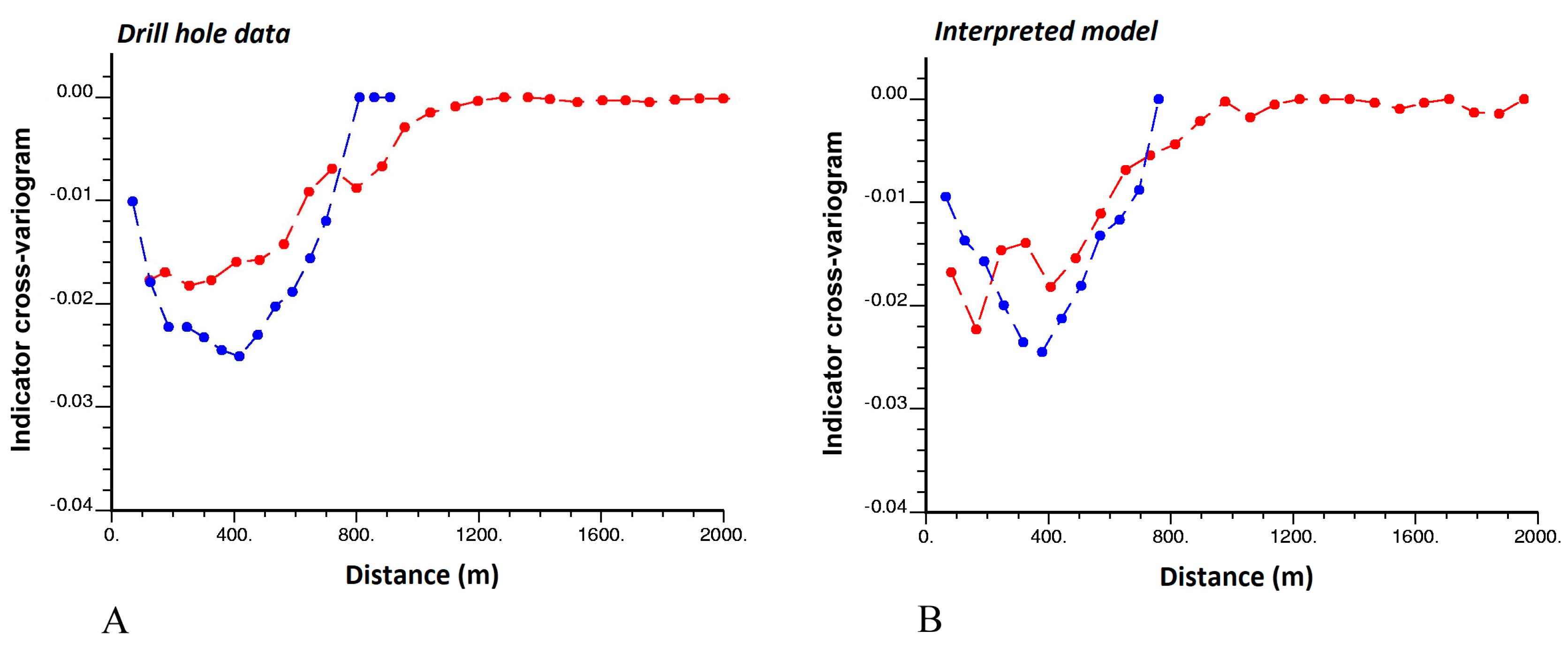
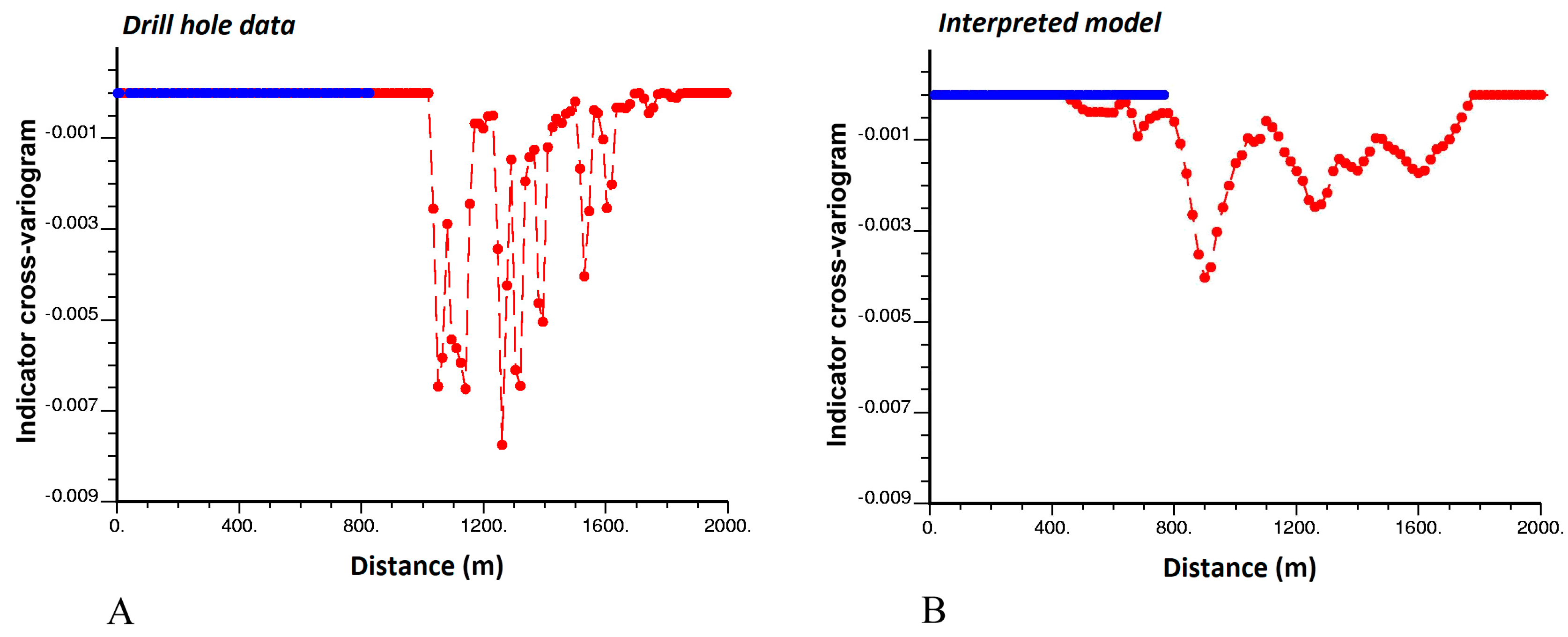
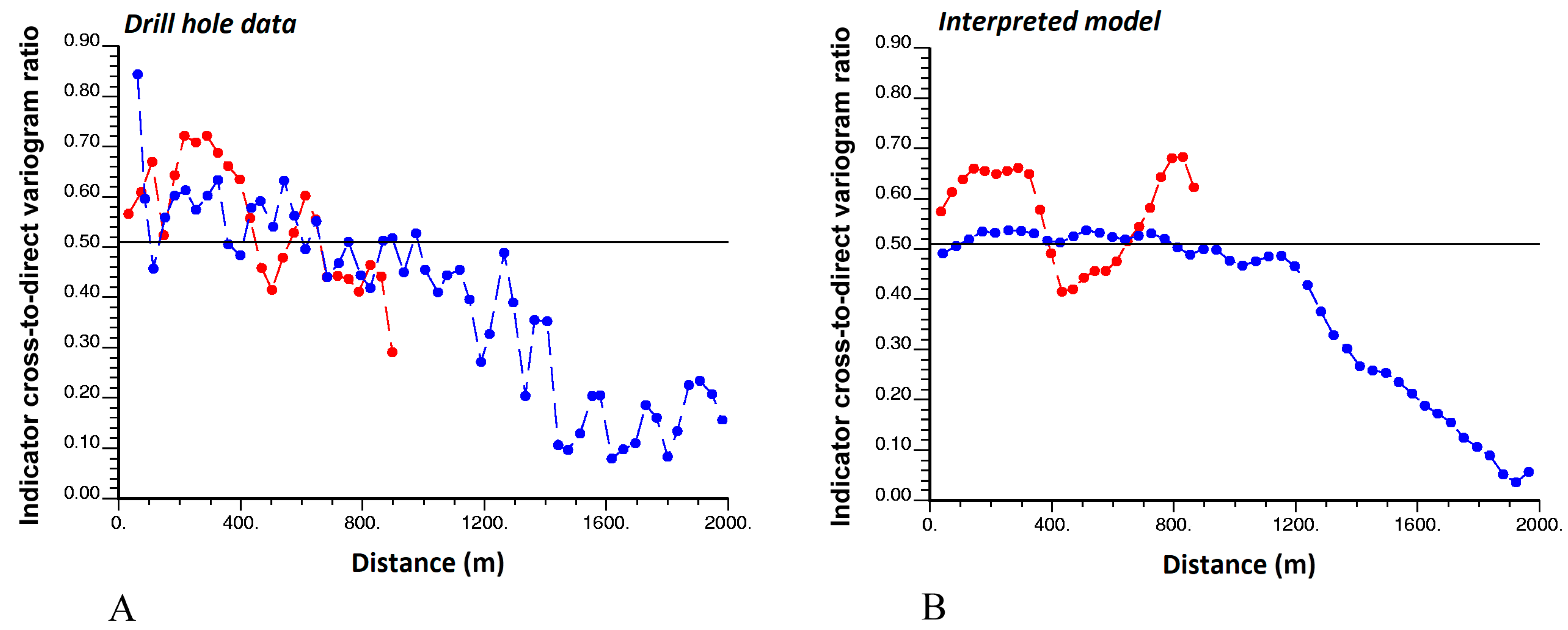
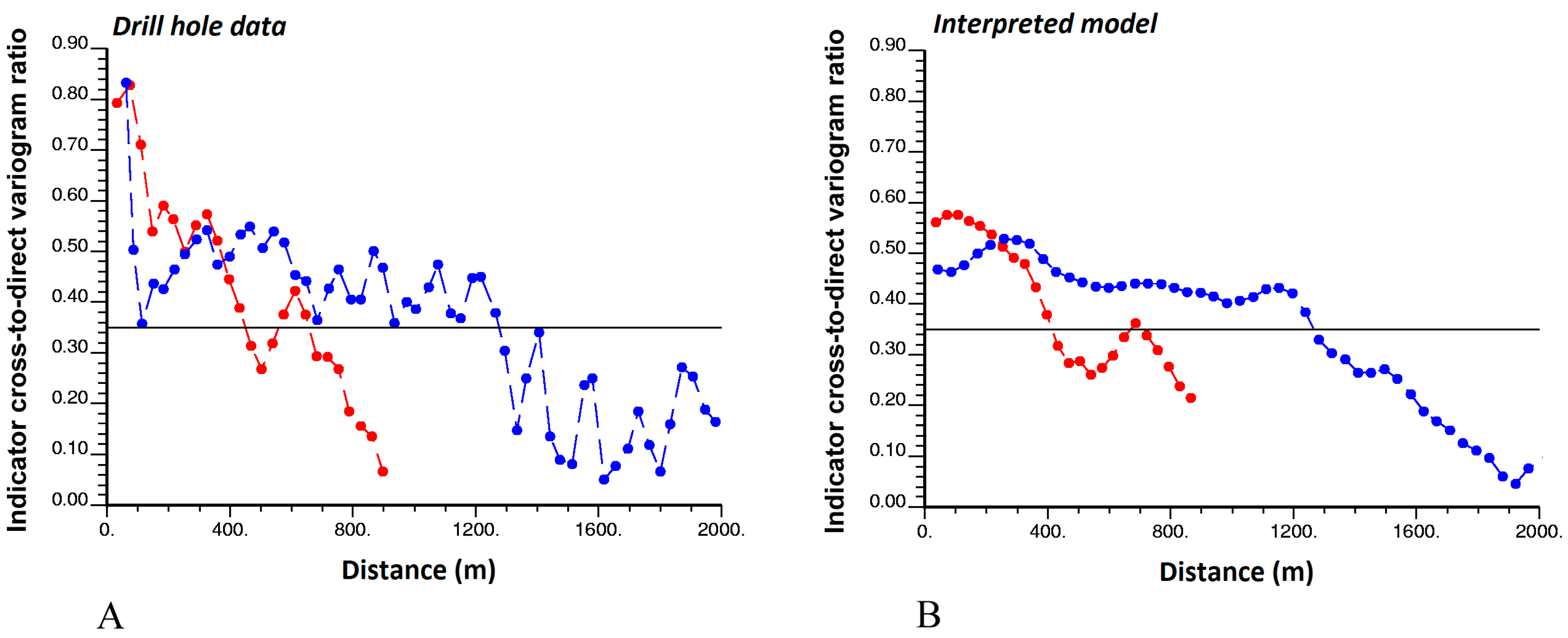
© 2017 by the authors. Licensee MDPI, Basel, Switzerland. This article is an open access article distributed under the terms and conditions of the Creative Commons Attribution (CC BY) license (http://creativecommons.org/licenses/by/4.0/).
Share and Cite
Maleki, M.; Emery, X.; Mery, N. Indicator Variograms as an Aid for Geological Interpretation and Modeling of Ore Deposits. Minerals 2017, 7, 241. https://doi.org/10.3390/min7120241
Maleki M, Emery X, Mery N. Indicator Variograms as an Aid for Geological Interpretation and Modeling of Ore Deposits. Minerals. 2017; 7(12):241. https://doi.org/10.3390/min7120241
Chicago/Turabian StyleMaleki, Mohammad, Xavier Emery, and Nadia Mery. 2017. "Indicator Variograms as an Aid for Geological Interpretation and Modeling of Ore Deposits" Minerals 7, no. 12: 241. https://doi.org/10.3390/min7120241



